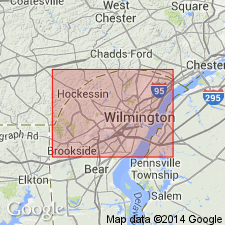
- Usage in publication:
-
- Windy Hills Gneiss
- Modifications:
-
- Original reference
- Dominant lithology:
-
- Gneiss
- Amphibolite
- AAPG geologic province:
-
- Piedmont-Blue Ridge province
Summary:
Pg. 11-12, 39; W.S. Schenck and others, 2000, Delaware Geol. Survey, Geol. Map. Ser., no. 10, scale 1:36,000. Windy Hills Gneiss of Wilmington Complex. Thinly interlayered, fine- to medium-grained hornblende-plagioclase amphibolite, biotite gneiss, and felsic gneiss, possibly metavolcanic. Metamorphic grade decreases from granulite facies in the northeast to amphibolite facies toward the southwest. Rocks previously included in amphibolite A and B of the Wilmington Complex and in James Run Formation. Is much older than the James Run at its type locality [459 +/-5 Ma, Horton and others, 1998, GSA Abs. w/Prog., v. 30, p. 126]. Is correlated (geol. map) with Big Elk Member of James Run Formation of Cecil County, Maryland. Age of igneous crystallization is [Early Ordovician], based on isotopic dating. Zircons from a sample of felsic biotite-gedrite-cordierite gneiss (locality Cb35-a) yielded a U-Pb age of 481 +/-4 Ma (J.N. Aleinikoff, USGS, personal commun., 2000).
Source: Publication.
For more information, please contact Nancy Stamm, Geologic Names Committee Secretary.
Asterisk (*) indicates published by U.S. Geological Survey authors.
"No current usage" (†) implies that a name has been abandoned or has fallen into disuse. Former usage and, if known, replacement name given in parentheses ( ).
Slash (/) indicates name conflicts with nomenclatural guidelines (CSN, 1933; ACSN, 1961, 1970; NACSN, 1983, 2005, 2021). May be explained within brackets ([ ]).

